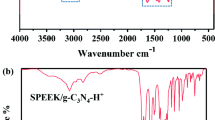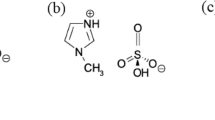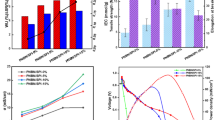Abstract
This paper focuses on the preparation and fuel cell application of an organic–inorganic composite membrane. The composite membranes are based on sulfonated polyimide and MIL-101(Fe)-NH2 metal–organic framework containing amino flexible side chains is introduced as filler which can form an acid–base pair through hydrogen bonding with sulfonic acid groups on the polymer main chain to increase ion transport channels. Then, the proton transport mechanism in the membrane is explained by discussing the internal structure of the filler and the blend membrane. Specifically, the peak stress intensity of the composite membrane can be enhanced to 132.5 MPa, and the proton conductivity can be significantly increased to 0.194 S cm−1, respectively. This improved performance can be attributed to the unique structure of MOF and the synergistic effect of amino modification, and the porous structure is conducive to the formation of continuous transmission path and the tightly acid–base electrostatic interactions can accelerates proton conduction through the Grotthus mechanism.
Graphical abstract
Structure and possible conduction mechanism of SPI-Fe@MOF hybrid membranes










Similar content being viewed by others
References
Liu H, Chen J, Hissel D, Lu J, Hou M, Shao Z (2020) Prognostics methods and degradation indexes of proton exchange membrane fuel cells: a review. Renew Sustain Energy Rev 123:109721. https://doi.org/10.1016/j.rser.2020.109721
Wang S, Zhao C, Ma W, Zhang G, Liu Z, Ni J, Li M, Zhang N, Na H (2012) Preparation and properties of epoxy-cross-linked porous polybenzimidazole for high temperature proton exchange membrane fuel cells. J Membr Sci 411:54–63. https://doi.org/10.1016/j.memsci.2012.04.011
Yin C, He C, Liu Q, Xiong B, Zhang X, Qian L, Li J, Zhou Y (2019) Free volume, gas permeation, and proton conductivity in MIL-101-SO3H/Nafion composite membranes. Phys Chem Chem Phys 21(47):25982–25992. https://doi.org/10.1039/c9cp04832d
Jing X, Li Y, Zhu J, Chang L, Maganti S, Naik N, Xu BB, Murugadoss V, Huang M, Guo Z (2022) Improving thermal conductivity of polyethylene/polypropylene by styrene-ethylene-propylene-styrene wrapping hexagonal boron nitride at the phase interface. Adv Compos Hybrid Mater. https://doi.org/10.1007/s42114-022-00438-x
Hu H, Ding F, Ding H, Liu J, Xiao M, Meng Y, Sun L (2020) Sulfonated poly(fluorenyl ether ketone)/Sulfonated α-zirconium phosphate nanocomposite membranes for proton exchange membrane fuel cells. Adv Compos Hybrid Mater 3(4):498–507. https://doi.org/10.1007/s42114-020-00182-0
Rosli RE, Sulong AB, Daud WRW, Zulkifley MA, Husaini T, Rosli MI, Majlan EH, Haque MA (2017) A review of high-temperature proton exchange membrane fuel cell (HT-PEMFC) system. Int J Hydrog Energy 42(14):9293–9314. https://doi.org/10.1016/j.ijhydene.2016.06.211
Liu H, Guo L, Liu M, Chen H, Han W, Bian H, Tian X, Wang C, Guo Z, Sun J (2022) Water management simulation of proton exchange membrane fuel cells with micro-ribs based on volume of fluid model. ES Energy Environ 15:45–55. https://doi.org/10.30919/esee8c530
Liu C, Xu D, Weng J, Zhou S, Li W, Wan Y, Jiang S, Zhou D, Wang J, Huang Q (2020) Phase change materials application in battery thermal management system: a review. Materials 13(20):4622. https://doi.org/10.3390/ma13204622
Xing P, Robertson GP, Guiver MD, Mikhailenko SD, Kaliaguine S (2004) Sulfonated poly(aryl ether ketone)s containing the hexafluoroisopropylidene diphenyl moiety prepared by direct copolymerization, as proton exchange membranes for fuel cell application. Macromolecules 37(21):7960–7967. https://doi.org/10.1021/ma0494941
Lee JK, Li W, Manthiram A (2009) Poly(arylene ether sulfone)s containing pendant sulfonic acid groups as membrane materials for direct methanol fuel cells. J Membr Sci 330(1–2):73–79. https://doi.org/10.1016/j.memsci.2008.12.043
Wang G, Lee KH, Lee WH, Shin DW, Kang NR, Cho DH, Hwang DS, Zhuang Y, Lee YM, Guiver MD (2014) Durable sulfonated poly(benzothiazole-co-benzimidazole) proton exchange membranes. Macromolecules 47(18):6355–6364. https://doi.org/10.1021/ma501409v
Shin DW, Lee SY, Kang NR, Lee KH, Guiver MD, Lee YM (2013) Durable sulfonated poly(arylene sulfide sulfone nitrile)s containing naphthalene units for direct methanol fuel cells (DMFCs). Macromolecules 46(9):3452–3460. https://doi.org/10.1021/ma400154t
Long J, Xu W, Xu S, Liu J, Wang Y, Luo H, Zhang Y, Li J, Chu L (2021) A novel double branched sulfonated polyimide membrane with ultra-high proton selectivity for vanadium redox flow battery. J Membr Sci 628:119259. https://doi.org/10.1016/j.memsci.2021.119259
Kumar AG, Singh A, Komber H, Voit B, Tiwari BR, Noori MT, Ghangrekar MM, Banerjee S (2018) Novel sulfonated co-poly(ether imide)s containing trifluoromethyl, fluorenyl and hydroxyl groups for enhanced proton exchange membrane properties: application in microbial fuel cell. ACS Appl Mater Interfaces 10(17):14803–14817. https://doi.org/10.1021/acsami.8b03452
Liu C, Zheng K, Zhou Y, Zhu K, Huang Q (2021) Experimental thermal hazard investigation of pressure and EC/PC/EMC mass ratio on electrolyte. Energies 14(9):2511. https://doi.org/10.3390/en14092511
Ding F, Hu H, Ding H, Liu J, Chen Y, Xiao M, Meng Y, Sun L (2020) Sulfonated poly(fluorene ether ketone) (SPFEK)/α-zirconium phosphate (ZrP) nanocomposite membranes for fuel cell applications. Adv Compos Hybrid Mater 3(4):546–550. https://doi.org/10.1007/s42114-020-00184-y
He G, He X, Wang X, Chang C, Zhao J, Li Z, Wu H, Jiang Z (2016) A highly proton-conducting, methanol-blocking nafion composite membrane enabled by surface-coating crosslinked sulfonated graphene oxide. Chem Commun 52(10):2173–2176. https://doi.org/10.1039/C5CC07406A
Liu L, Guo Z, Yang J, Wang S, He Z, Wang C (2021) High ion selectivity aquivion-based hybrid membranes for all vanadium redox flow battery. Adv Compos Hybrid Mater 4(3):451–458. https://doi.org/10.1007/s42114-021-00261-w
Nguyen MDT, Dang HS, Kim D (2015) Proton exchange membranes based on sulfonated poly(arylene ether ketone) containing triazole group for enhanced proton conductivity. J Membr Sci 496:13–20. https://doi.org/10.1016/j.memsci.2015.08.029
Kreuer KD, Fuchs A, Ise M, Spaeth M, Maier J (1998) Imidazole and pyrazole-based proton conducting polymers and liquids. Electrochim Acta 43(10):1281–1288. https://doi.org/10.1016/S0013-4686(97)10031-7
Kim J-D, Oba Y, Ohnuma M, Mori T, Nishimura C, Honma I (2010) Physico-chemical properties of temperature tolerant anhydrous Nafion-benzimidazole blend membrane. Solid State Ion 181(23–24):1098–1102. https://doi.org/10.1016/j.ssi.2010.06.008
Li X, Wang P, Liu Z, Peng J, Shi C, Hu W, Jiang Z, Liu B (2018) Arylether-type polybenzimidazoles bearing benzimidazolyl pendants for high-temperature proton exchange membrane fuel cells. J Power Sources 393:99–107. https://doi.org/10.1016/j.jpowsour.2018.05.011
Wang B, Sun X, Xie X, Wang J, Li L, Jiao K (2021) Experimental investigation of a novel cathode matrix flow field in proton exchange membrane fuel cell. ES Energy Environ 12:95–107. https://doi.org/10.30919/esee8c422
Lee CH, Min KA, Park HB, Hong YT, Jung BO, Lee YM (2007) Sulfonated poly(arylene ether sulfone)–silica nanocomposite membrane for direct methanol fuel cell (DMFC). J Membr Sci 303(1–2):258–266. https://doi.org/10.1016/j.memsci.2007.07.026
He X, He G, Zhao A, Wang F, Mao X, Yin Y, Cao L, Zhang B, Wu H, Jiang Z (2017) Facilitating proton transport in Nafion-based membranes at low humidity by incorporating multifunctional graphene oxide nanosheets. ACS Appl Mater Interfaces 9(33):27676–27687. https://doi.org/10.1021/acsami.7b06424
Li Y, Wang H, Wu Q, Xu X, Lu S, Xiang Y (2017) A poly(vinyl alcohol)-based composite membrane with immobilized phosphotungstic acid molecules for direct methanol fuel cells. Electrochim Acta 224:369–377. https://doi.org/10.1016/j.electacta.2016.12.076
Ho WH, Li SC, Wang YC, Chang TE, Chiang YT, Li YP, Kung CW (2021) Proton-conductive cerium-based metal-organic frameworks. ACS Appl Mater Interfaces 13(46):55358–55366. https://doi.org/10.1021/acsami.1c17396
Duan Y, Ru C, Li J, Sun YN, Pu X, Liu B, Pang B, Zhao C (2022) Enhancing proton conductivity and methanol resistance of SPAEK membrane by incorporating MOF with flexible alkyl sulfonic acid for DMFC. J Membr Sci 641:119906. https://doi.org/10.1016/j.memsci.2021.119906
Wu Y, Liu X, Yang F, Zhou LL, Yin B, Wang P, Wang L (2021) Achieving high power density and excellent durability for high temperature proton exchange membrane fuel cells based on crosslinked branched polybenzimidazole and metal-organic frameworks. J Membr Sci 630:119288. https://doi.org/10.1016/j.memsci.2021.119288
Liang X, Zhang F, Feng W, Zou X, Zhao C, Na H, Liu C, Sun F, Zhu G (2013) From metal–organic framework (MOF) to MOF–polymer composite membrane: enhancement of low-humidity proton conductivity. Chem Sci 4(3):983–992. https://doi.org/10.1039/c2sc21927a
Li Z, He G, Zhang B, Cao Y, Wu H, Jiang Z, Tiantian Z (2014) Enhanced proton conductivity of Nafion hybrid membrane under different humidities by incorporating metal-organic frameworks with high phytic acid loading. ACS Appl Mater Interfaces 6(12):9799–9807. https://doi.org/10.1021/am502236v
Sapegin DA, Gubanova GN, Kruchinina EV, Volkov AY, Popova EN, Vylegzhanina ME, Setnickova K, Kononova SV (2021) On the structure, morphology and transport through limitedly flexible chain sulfonated co-polyimide. Polymer 212:123142. https://doi.org/10.1016/j.polymer.2020.123142
Liu L, Wang C, He Z, Pan D, Dong B, Vupputuri S, Guo Z (2021) Revisiting Nafion membranes by introducing ammoniated polymer with norbornene to improve fuel cell performance. J Power Sources 506:230164. https://doi.org/10.1016/j.jpowsour.2021.230164
Yin C, Li J, Zhou Y, Zhang H, Fang P, He C (2018) Enhancement in proton conductivity and thermal stability in Nafion membranes induced by incorporation of sulfonated carbon nanotubes. ACS Appl Mater Interfaces 10(16):14026–14035. https://doi.org/10.1021/acsami.8b01513
Xin L, Zhang D, Qu K, Lu Y, Wang Y, Huang K, Wang Z, Jin W, Xu Z (2021) Zr-MOF-enabled controllable ion sieving and proton conductivity in flow battery membrane. Adv Funct Mater 31(42):2104629. https://doi.org/10.1002/adfm.202104629
Wang L, Deng N, Wang G, Ju J, Cheng B, Kang W (2019) Constructing amino-functionalized flower-like metal-organic framework nanofibers in sulfonated poly(ether sulfone) proton exchange membrane for simultaneously enhancing interface compatibility and proton conduction. ACS Appl Mater Interfaces 11(43):39979–39990. https://doi.org/10.1021/acsami.9b13496
Yin Y, Wang H, Cao L, Li Z, Li Z, Gang M, Wang C, Wu H, Jiang Z, Zhang P (2016) Sulfonated poly(ether ether ketone)-based hybrid membranes containing graphene oxide with acid-base pairs for direct methanol fuel cells. Electrochim Acta 203:178–188. https://doi.org/10.1016/j.electacta.2016.04.040
Wang J, He Y, Zhao L, Li Y, Cao S, Zhang B, Zhang H (2015) Enhanced proton conductivities of nanofibrous composite membranes enabled by acid–base pairs under hydrated and anhydrous conditions. J Membr Sci 482:1–12. https://doi.org/10.1016/j.memsci.2015.02.015
da Trindade LG, Borba KMN, Zanchet L, Lima DW, Trench AB, Rey F, Diaz U, Longo E, Bernardo-Gusmão K, Martini EMA (2019) SPEEK-based proton exchange membranes modified with MOF-encapsulated ionic liquid. Mater Chem Phys 236:121792. https://doi.org/10.1016/j.matchemphys.2019.121792
Erkartal M, Usta H, Citir M, Sen U (2016) Proton conducting poly(vinyl alcohol) (PVA)/ poly(2-acrylamido-2-methylpropane sulfonic acid) (PAMPS)/ zeolitic imidazolate framework (ZIF) ternary composite membrane. J Membr Sci 499:156–163. https://doi.org/10.1016/j.memsci.2015.10.032
Wang S, Luo H, Li X, Shi L, Cheng B, Zhuang X, Li Z (2021) Amino acid-functionalized metal organic framework with excellent proton conductivity for proton exchange membranes. Int J Hydrog Energy 46(1):1163–1173. https://doi.org/10.1016/j.ijhydene.2020.09.235
Zhang Z, Ren J, Xu J, Wang Z, He W, Wang S, Yang X, Du X, Meng L, Zhao P (2020) Adjust the arrangement of imidazole on the metal-organic framework to obtain hybrid proton exchange membrane with long-term stable high proton conductivity. J Membr Sci 607:118194. https://doi.org/10.1016/j.memsci.2020.118194
Fang J, Guo X, Xu H, Okamoto KI (2006) Sulfonated polyimides: synthesis, proton conductivity and water stability. J Power Sources 159(1):4–11. https://doi.org/10.1016/j.jpowsour.2006.04.038
Funding
This work was supported by the National Key R & D Program of China (Project No. 2021YFE0104700). The authors would like to acknowledge the financial support of Taif University Researchers Supporting Project number (TURSP-2020/189), Taif University, Taif, Saudi Arabia.
Author information
Authors and Affiliations
Corresponding authors
Ethics declarations
Competing interests
The authors declare no competing interests.
Additional information
Publisher's Note
Springer Nature remains neutral with regard to jurisdictional claims in published maps and institutional affiliations.
Supplementary Information
Below is the link to the electronic supplementary material.
Rights and permissions
About this article
Cite this article
Yang, J., Tong, L., Alsubaie, A.S. et al. Hybrid proton exchange membrane used in fuel cell with amino-functionalized metal–organic framework in sulfonated polyimide to construct efficient ion transport channel. Adv Compos Hybrid Mater 5, 834–842 (2022). https://doi.org/10.1007/s42114-022-00469-4
Received:
Revised:
Accepted:
Published:
Issue Date:
DOI: https://doi.org/10.1007/s42114-022-00469-4




